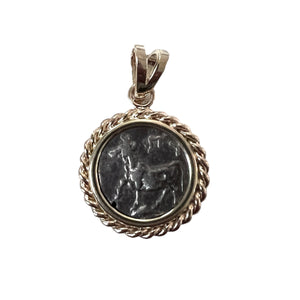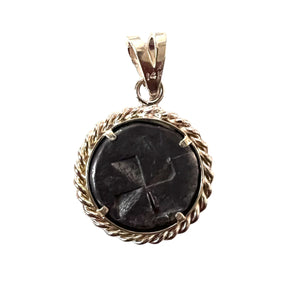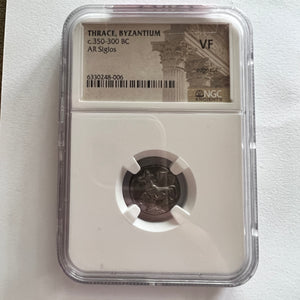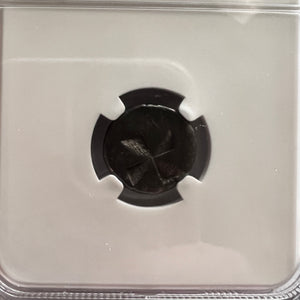Ancient Thrace, Byzantine - AR Hemidrachm (Siglos) - Circa 387-340 BC
$1,900
Denomination: AR Hemidrachm
Date: Circa 387-340 BC
Mint: Thrace, Byzantium
Mount: 14K twisted gold
Grade: NGC – 6330248-006. VF details.
Description: Thrace, Byzantium. AR half-siglos or Hemidrachm (14mm), edge cut. Obverse: Bull standing left on dolphin left; ΠY above. Reverse: Quadripartite incuse square of mill sail pattern.
History: The lion, King of Beasts, was used prominently on ancient coins from the very inception of coinage, between 650 and 600 BCE. These coins were minted in Thracian Cherronesos (AKA Cheronese) about 400-350 BCE. This Hemidrachm was minted in Thracian Chersoneses, an Ancient Greek colony of 12 cities strategically located along shipping routes on the Northern Aegean Sea. The chersoneses Peninsula (modern-day Gallipoli, Turkey) was eventually ceded to Philip II of Macedon in 338 BCE after becoming the focus of a bitter terrestrial dispute between the King of Macedon and the Greek city of Athens.
Thrace was just north and east of Macedonia on the Aegean Sea. Greek Colonists settled this area during the 8th and 7th centuries BCE. The interior areas were primarily populated by the indigenous tribes. They became partially Hellenized by contact with the Greeks. Their contact with the Greeks was mainly in the form of trade. They had significant silver mines available and struck coins for mainly for trade purposes. Although lions are not indigenous to Greek lands, their image was used during the Greek Classical Period, and were widespread along the trade routes of the Black Sea. chersonese’s coinage often depicted scenes "close to nature," which explains the Lion motif of the obverse and many of the reverse symbols, which range from lizards and bees to grains and grapes.
61051








